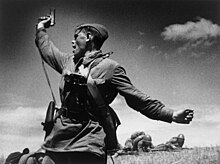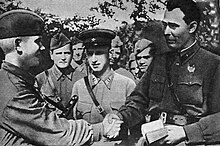Political commissar
This articleneeds additional citations forverification.(July 2022) |

In themilitary,apolitical commissarorpolitical officer(orpolitruk,a portmanteau word fromRussian:политический руководитель,romanized:politicheskiy rukovoditel;transl. political leaderor political instructor) is a supervisoryofficerresponsible for the political education (ideology) and organization of theunitto which they are assigned, with the intention of ensuring political control of the military.
The function first appeared ascommissaire politique(political commissioner) orreprésentant en mission(representative on mission) in theFrench Revolutionary Armyduring theFrench Revolution(1789–1799).[1]Political commissars were heavily used within theInternational Brigadesduring theSpanish Civil War(1936–1939). They also existed, with interruptions, in the SovietRed Armyfrom 1918 to 1991, as well as in the armed forces ofNazi Germanyfrom 1943 to 1945 asNationalsozialistische Führungsoffiziere(national socialist leadership officers).
The function remains in use in China'sPeople's Liberation Army,Taiwan'sRepublic of China Army,and Vietnam'sPeople's Army.In fiction, The Hunt for Red October by Tom Clancy features the murder of the eponymous Soviet submarine's political officer (Zampolit) as the incident that sets Captain Ramius’ long-planned defection scheme in motion.
China[edit]
People's Republic of China[edit]
The position of political commissar (Chinese:Chính ủy) existed in theChinese Red Armysince the Sanwan Reorganization of 1927 (Chinese:Tam loan cải biên), which established military organizations at various levels with Chinese Communist Party committees. The practice was formalized with the principle of the "Party commands the gun" (Chinese:Đảng chỉ huy thương) at the Gutian Conference of 1929. Red Army was part of the Communist revolution forces; thusMao Zedonghad constantly emphasized its role in both combat and political missions. The political commissioners were tasked to teach communist ideologies to internal members of the Red Army, as well as propaganda tasks targeting the enemy by showing the Red Army as a righteous force.[2]
In thePeople's Liberation Army(PLA), each level of the command has a dual-command structure, with a military organ and a Party organ. This collective leadership is held between the military commander (Chinese:Quân sự chủ quan) and political commander (Chinese:Chính trị chủ quan,i.e. the political commissar).[3]The political commissar is always a uniformed military officer with both tactical and political training andChinese Communist Party cadre.In the past, this position has been used to give civilian party officials some experience with the military.[4]
Usually, the operational command organ has the military commander as the highest decision maker, while the political commissar serves as the second-in-command. As the deputy, political commissar are largely responsible for administrative tasks such as public relations, unit welfare, mental health, morale, and political education.[4][3]The Party organs are chaired by the political commissar, with the military commanders serving as the deputy secretaries. This framework ensures that both military and political officers can collectively design the goals and tasks of their respective units.[2]
The role of the political commissar is not universal across different branches of the PLA. In theGround Forces,the political commissar is often second-in-command, while the military officer is responsible for the operation. Whereas in thePeople's Liberation Army Navy(PLAN), the political commissar and the Party committee are the supreme decision-makers, while military works are delegated to the operational commander as the second-in-command.[2]
Republic of China[edit]

The position of political commissar (Chinese:Chính chiến quan,literal translation "Political Warfare Officer" ) also existed in theRepublic of China Armyof theRepublic of China(Taiwan).Chiang Ching-kuo,appointed asKuomintang(Chinese Nationalist Party) director of Secret Police in 1950, was educated in the Soviet Union, and initiated Soviet-style military organization in theRepublic of China Armed Forces,reorganizing and Sovietizing the political officer corps, surveillance, and Kuomintang party activities were propagated throughout the military. Opposed to this was GeneralSun Li-jen,who was educated at the AmericanVirginia Military Institute.[5]Chiang Ching-kuo then arrested Sun Li-jen, charging him of conspiring with the AmericanCentral Intelligence Agencyof plotting to overthrowChiang Kai-shekand the Kuomintang. Sun was placed under house arrest in 1955.[6][7]
Today, political commissars belong to thePolitical Warfare Bureau(Chinese:Chính trị tác chiến cục) and are still responsible for the planning and supervision of the political operations of the Republic of China Army where they are involved in psychological warfare, preparing propaganda for external consumption, along with providing counseling, psychological warfare training and processing news for the Taiwanese military.[8]
Soviet Union and the Eastern Bloc[edit]
You can helpexpand this section with text translated fromthe corresponding articlein Russian.(April 2024)Click [show] for important translation instructions.
|


An early kind of political commissar was established during theFebruary Revolution1917 as theIspolkomissued the controversialOrder no 1.[9]As theBolshevikscame to power through theOctober Revolutionof November 1917, and as theRussian Civil Warof 1917–1922 began,Leon Trotskygradually established theRed Armyand set up the role of political officers. They were tasked with making sure thatcommunist partiescould count on the loyalty of armed forces. Although there was a huge difference between the February Revolution and the October Revolution, their leaders in each case feared a counter-revolution, and both regarded the military officers as the most likely counter-revolutionary threat.[10][11]
Later commissars in the Eastern bloc could exercise broader roles insocial engineering.[12]
In the Soviet Union[edit]

In the Red Army (1918–1946) and theSoviet Army(1946–1991), thepolitical commissar(Russian:комиссар,romanized:komissar) existed, by name, only during the 1918–1924, 1937–1940, and 1941–1942 periods; not every Red Army political officer was a commissar. The political commissar held military rank equaling the unit commander to whom he was attached; moreover, the commissar also had the military authority to countermand the unit-commander's orders at any time. During the other periods of the Red Army's history political officers were militarily subordinate to unit commanders, and the position of political commissar did not exist.
The political supervision of the Russian military was effected by the political commissar, who was present in every unit and formation, fromcompany- todivision-level, including in the navy.Revolutionary Military Councils(or Revvoyensoviets, RVS) were established atarmy-,front-,fleet-, andflotilla-level, comprising at least three members—the commander and two political workers. The political workers were denominated "members of the RVS", not "commissars", despite their position as official political commissars.
In 1919, the titlepolitruk(Russian:политрук, from политический руководитель, political leader) was assigned to political officers atcompanylevel. Despite their position as official political commissars, they were not addressed as "commissar". Beginning in 1925, the politico-military doctrinal course towardedinonachalie(Russian:единоначалие,single command) was established, and the political commissar, as a military institution, faded. The introduction ofedinonachaliewas two-fold, either the military commander joined theCommunist Partyand became his own unit's political officer, or apompolit(Russian:помполит,assistant commander for political work) officer was commissioned sub-ordinate to him. Earlier, in 1924, the RVSs were renamed as Military Councils, such high-level political officers were known as ChVS (Chlen Voennogo Soveta,Member of the Military Council); they were abolished in 1934.
On 10 May 1937, the role of political commissar was reinstated in the Red Army, and Military Councils were set up. These derived from the politicalpurgesin the Soviet armed forces. Again, in August 1940, the office of political commissars was abolished, yet the Military Councils continued throughout theGerman-Soviet War(1941–1945), and after. Belowarmylevel, theedinonachalie(single-command) system was restored. In July 1941, consequent to the Red Army's defeats at the war's start, the position of political commissar reappeared. The commissars had an influential role as "second commanders" within the military units during this time. Their rank and insignia generally paralleled those of officers. Because this proved ineffective,General Konevasked Stalin to subordinate the political officer to commanding officers: the commissars' work was re-focused tomorale-related functions. The term "commissar" was abolished in August 1942, and at the company- and regiment-level, thepompolitofficer was replaced with thezampolit(deputy for political matters). Although no longer known by the original "commissar" title, political officers were retained by all theSoviet Armed Forces,e.g.,Army,Navy,Air Force,Strategic Missile Troops,et al,until thedissolution of the Soviet Unionin 1991.
Red Army rank designations[edit]
- Armeysky komissar 1-go ranga(Army Commissar 1st rank)
- Armeysky komissar 2-go ranga(Army Commissar 2nd rank)
- Korpusnoy komissar(Commissar of the corps)
- Divizionny komissar(Commissar of the division)
- Brigadny komissar(Commissar of the brigade)
- Polkovoy komissar(Commissar of the regiment)
- Starshi batalonny komissar(Senior commissar of the battalion)
- Batalonny komissar(Commissar of the battalion)
- Starshy politruk(Senior politleader)
- Politruk(Politleader)
- Mladshy politruk(Junior politleader)
Eastern Bloc armies[edit]
After World War II, otherEastern Blocarmies also used political officers patterned on the Soviet model. For example,East Germany'sNational People's ArmyusedPolitoffiziereas the unit commander's deputy responsible for political education. During theKorean War,theKorean People's Armycommissars were known as "Cultural Sections" or "Political Sections".[13]
See also[edit]
References[edit]
Citations[edit]
- ^R. Dupuy,Nouvelle histoire de la France contemporaine: La République jacobine(2005) p.156
- ^abcBenson, J. W.; Yang, Z (2020)."The Role of the Political Commissar".In Party on the Bridge: Political Commissars in the Chinese Navy.Center for Strategic and International Studies (CSIS): 9–21.
- ^abRawson, Payton (13 November 2023)."How China commands its 'people's army'".The Strategist.
- ^abBeckley, Michael (2018).Unrivaled: Why America Will Remain the World's Sole Superpower.Cornell University Press. p. 67.doi:10.7591/9781501724794.ISBN978-1-5017-2479-4.
- ^Jay Taylor (2000).The Generalissimo's son: Chiang Ching-kuo and the revolutions in China and Taiwan.Harvard University Press. p. 195.ISBN0-674-00287-3.Retrieved2010-06-28.
- ^Peter R. Moody (1977).Opposition and dissent in contemporary China.Hoover Press. p. 302.ISBN0-8179-6771-0.Retrieved2010-11-30.
- ^Nancy Bernkopf Tucker(1983).Patterns in the dust: Chinese-American relations and the recognition controversy, 1949-1950.Columbia University Press. p. 181.ISBN0-231-05362-2.Retrieved2010-06-28.
- ^"Chính trị tác chiến cục tóm tắt".Archived fromthe originalon 2010-10-11.Retrieved2010-09-11.
- ^Richard Pipes,The Russian Revolution,SwedishISBN91-27-09935-0,pp 106-108
- ^Richard Pipes,The Russian Revolution,SwedishISBN91-27-09935-0,p.120.
- ^Isaac Deutscher,Stalin,2nd edition, 1961, SwedishISBN91-550-2469-6,pp.168-169.
- ^
For example:
Podgórecki, Adam(1996). "Sociotechnics: Basic Problems and Issues". InPodgórecki, Adam;Alexander, Jon;Shields, Rob(eds.).Social Engineering.McGill-Queen's Press - MQUP. p. 31.ISBN9780886292706.Retrieved20 November2021.
Each institution (including universities) [in Poland in 1981] received a military 'commissar' who supervised both the administrative work and the political atmosphere.
- ^Appleman, Roy E. (1998).South to the Naktong, North to the Yalu: United States Army in the Korean War.Department of the Army.p. 350.ISBN978-0-16-001918-0.Archived fromthe originalon 2014-02-07.Retrieved2022-08-17.
Sources[edit]
- The Soviet Military Encyclopedia.
- Müller, Rolf-Dieter(2016).Hitler's Wehrmacht, 1935-1945.Translated by Ancker, Janice W. University Press of Kentucky.ISBN9780813168043.
